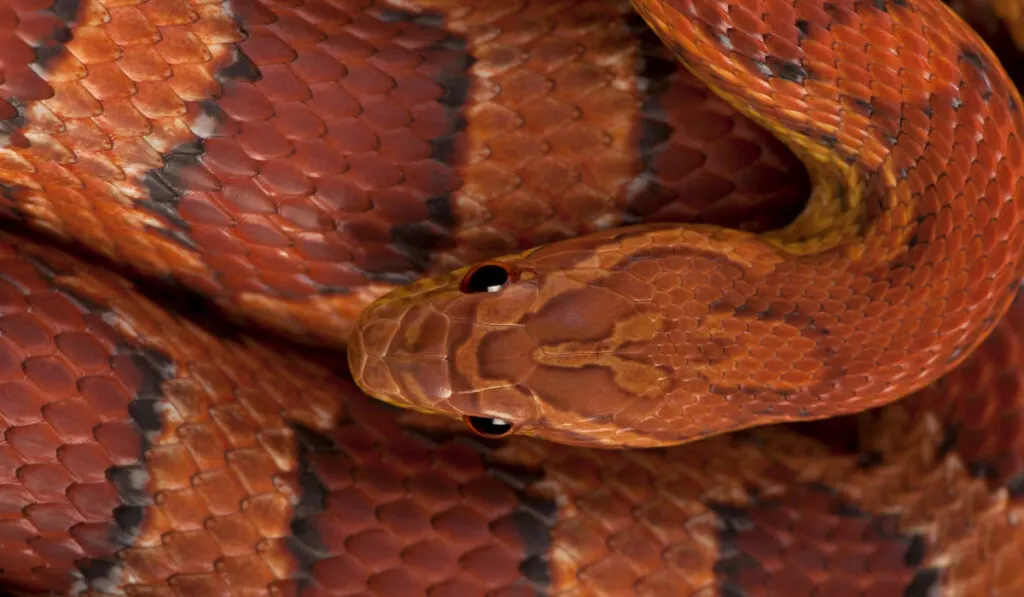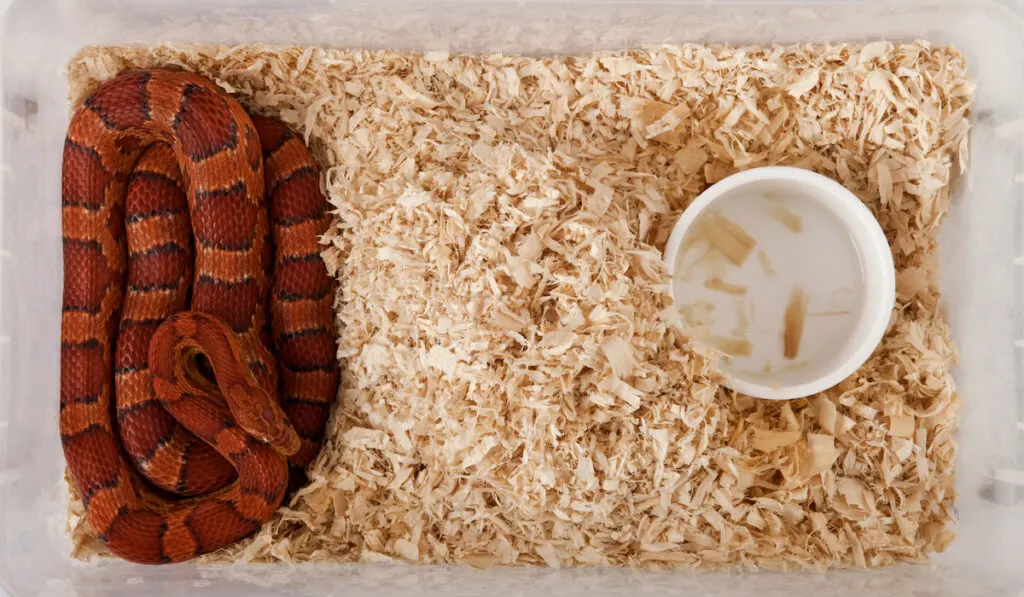If you are thinking of getting a corn snake as a pet, congratulations! Corn snakes are docile and easy going pets that make a great addition to your family. Before you bring your snake home, you will need to pick out a tank for it to live in.
What size tank for corn snake? A tank for a corn snake should be between 30 inches by 12 inches for a baby snake and 36 inches by 18 inches for an adult snake.

How do you know when to make the transition to a large tank? We will go into more detail about that below, along with some additional information about how to keep your corn snake comfortable and happy.
Table of Contents
What Size Tank?
Corn snakes are prolific for a reason. Their conservation status is listed as “Least Concern” which is as far from extinction as you can get. And that is no accident. In the wild, corn snakes are opportunistic.
Corn snakes are most commonly seen hunting the mice and rats that break into corn silos and storage, which is how they got their name. They are a farmer’s best friend.
They will be yours too, as long as you have a good tank that makes them happy. If you acquire a corn snake when it is young, a 30 inch by 12 inch tank will be perfectly fine.
This will give him or her ample space to move around and explore without feeling too constricted. This size is relatively small and can fit nicely on a dresser or table for your viewing pleasure.
When Slytherin (or whatever you decide to name your snake) gets older, he or she might not have enough room to move around and will start to feel cramped.
Although corn snakes are about as harmless as a housecat, you likewise do not want them to get tense and aggravated. Before that happens, consider upgrading to the larger 36 inch by 18 inch tank.

Why Can’t I Just Get a Large Tank Now?
Although buying one large tank seems like the more economical route, it will not work out like you think. Why? Well, adult tanks often have sliding doors and additional cracks for breathing. This is better for adults, as well as you when you pick up the snake so you do not have to lift it out of the top.
But all these additional crevices mean your tiny young corn snake can escape. If they can escape, they most certainly will. Watch for the following problem specifications when buying your corn snake’s first tank:
- Holes large than an eighth of an inch in diameter
- Sliding doors
- Cracks if the tank is used
- Insufficient top– If the top has holes and the tank has climbable accessories, your snake will climb up and escape that way too.
It is awfully hard to find a corn snake once it escapes, especially since they have colors that camouflage well in a home. They also are mostly silent, unlike a barking dog for instance. So bite the bullet and buy two different tanks.
Necessary Tank Accessories
Besides the tank itself, there are a few other things you will want to consider buying to keep your corn snake busy and comfortable in its new home.
Bedding/Substrate
So you have your tank, but your corn snake cannot just sit on plain glass 24 hours a day, 7 days a week. You would not want to sit on the floor all the time, would you? Of course not. A corn snake’s “couch,” so to speak, is a layer of material they can crawl over and into for:
- Warmth
- Comfort
- Hiding out from any perceived danger
- Laying eggs
This material is called bedding or substrate. There is no universally accepted best type of bedding, so here are a few so that you can choose the one you prefer:
- Aspen
- Pale, shredded wood fiber
- Little dust
- Scent-free
- Absorbent, which makes it easier to scoop out waste
- Great for tunneling and hiding
- Cypress mulch– similar to aspen
- Reptile bark or carpet
- Recycled paper or newspaper– needs to be changed quite often and is not as comfortable
Any of those will work fine, but you get what you pay for. While paper works just fine, you will probably better appreciate aspen or mulch. Do not use these kinds of wood mulches though, as they can be toxic to your corn snake and also can get too hot:
- Resinous
- Cedar
- Pine
- Fir
- Walnut
Temperature and Humidity Features
Corn snakes need a certain amount of humidity that is a bit more than what humans prefer. If its environment is too dry, it will have problems shedding.
If your snake is shedding fine and no water droplets are forming on the side of the tank, you probably have the humidity just right. If not, here are a few steps you can take to ensure proper snake hydration:
- Try adjusting the air conditioning in your home first.
- If that does not work, set some newspaper on top of the screen lid of the tank. Experiment with covering various amounts of the screen until you find the sweet spot of coverage. Remember, your corn snake also breaths through that screen, so you want to cover it without restricting air flow too much.
- Water bowl placement is key. Keep it small (3 to 6 inches) but replenished. For young snakes, place it in a corner. For adults, put the bowl more towards the middle of the tank.
Temperature itself is also a big factor. Unlike your pet dog or cat, corn snakes are reptiles that need variations in temperature in order to carry out various bodily functions. Of course, as long as your tank is inside your home, you cannot be expected to play with the thermostat all day every day.
To get around that, you need to make different temperature zones within your tank. Placing part of the tank under a window sill, so that only part of it gets sunlight throughout the day, is an easy workaround. If that is not an option, try placing one of these heating lamps over part of the enclosure:
Other Accessories
Besides those necessities and the obvious need for food and waste cleaning, corn snakes deserve a fun quality of life. Consider these additional accessories to keep you snake feeling happy.
Hides
Sure, your snake can always just hide under the bedding, but do you not want it to have somewhere completely dark and secluded? Getting a larger, above surface hide will allow your corn snake to cool off easier and get some quality sleep. Consider one of these hides:
- Pangea Reptile Hide Box– A simple box that gets the job done
- Zilla Small Rock Lair– Heavy so it will not move and scare your snake. Also has a solid top to help hold humidity.
- Zilla Reptile Habitat Décor Hideouts Bark Bends– It has a lot more holes then the other ones. That makes it easier for your snake to move about, but also limits the amount of cool temperature that can be kept inside.
Climbing Branches
Flat surfaces are only fun for so long. Corn snakes love to climb for exploration and exercise. Again, if you add these in, which you should, you should definitely make sure the lid of your tank is secure.
If it is still a baby, make sure the holes of the screen are small enough to prevent it from slipping through. Here a few good ideas for climbing branches:
- EONMIR 8-foot reptile vines– It is flexible so you can set it up any way you want. If your snake (or you) is getting bored, change it up!
- Tfwadmx reptile bend-a-branch vines– A 2-pack, but a little more basic
- POPETPOP– Give the tank a little more of a jungle aesthetic
